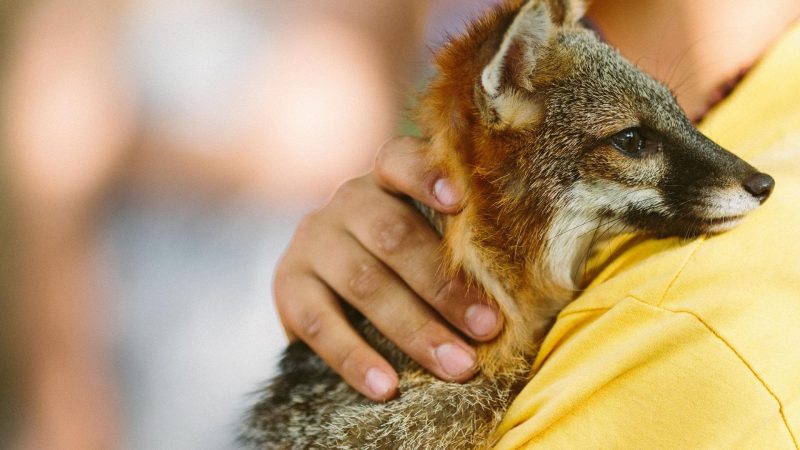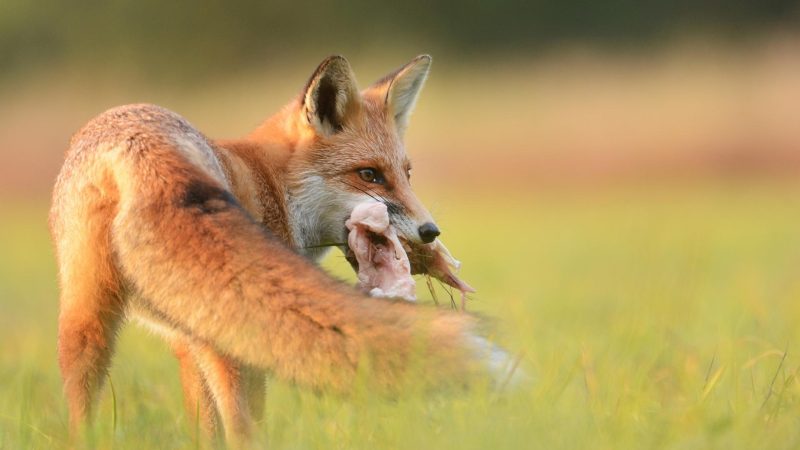You may have seen some people have red foxes as pets, and you can’t help but be fascinated. Also, you’ll wonder how they handle it.
Can you have a pet fox? Do they make good pets? Unfortunately, they don’t make good pets because of the following reasons:
- Extremely energetic – Foxes possess high energy. When they don’t receive the appropriate enrichment, they will find their way out of the house due to boredom.
- So loud – Foxes are known as cunning creatures, but it screams loudly at night, especially in mating season.
- Habit of marking territory – Foxes like marking their territories, and they fill your house with animal smells.
Although there are downsides to having a pet fox, some can handle them, and you may try it too. If you want to know more about the process and other factors in getting a pet fox, read on.
Table of Contents
Can Foxes Bond With Humans?

Only domesticated foxes can bond with humans. These are silver foxes that went through selective breeding in the 1950s. They’re eager to get near humans and fine with being petted.
Moreover, they’re like dogs too that wag their tails and raise their ears.
Do Foxes Make Good Pets?
Unfortunately, even a domesticated fox doesn’t make a good pet. Despite the urge to bond with humans, it demands extra attention and shows unconventional habits.
Even though the domesticated foxes are created for human attachment, they can’t just let off their nature like howling at night. This can’t be prevented, especially in mating season.
Foxes have the habit of marking their territory. When a pet fox does this, your house will be filled with the animal smell. You can counter this by using an odor neutralizer or air purifier. As mentioned, you have to pay extra attention to a pet fox specifically with its diet.
When they get hungry and bored, they don’t run out of energy which is used for finding ways on how to get out of the house. Due to this concern, you may not be able to travel on vacation.
Have Foxes Been Domesticated?
Both foxes and dogs are from the Canidae family, but they’re different. Foxes are still considered wild animals, and dogs are one of the domesticated animals that live with humans for thousands of years.
In the late 1950s, Dmitry K. Belyaev, a Soviet geneticist, worked on creating domesticated foxes. The project is called the ‘Farm Fox Experiment’. They bred the wild silver foxes to tame them.
The experiment is successful specifically with the behavioral trait of gentleness and heredity of domestication. The program that he started continues after five decades in Novosibirsk, Siberia under the supervision of the Institute of Cytology and Genetics.
By unlocking the factors of domestication and physical traits, breeding, and behavior of foxes, the domesticated foxes from the Siberian facility are likable. You can get it as long as you’re willing to give your pet fox extra attention and deal with a bit of an unconventional setting.
The direct breeding in this project was able to produce domesticated foxes with the exact image of the wild fox. They know how to adapt to living with humans since they’re tamed.
They like getting attention from people as they wag their fluffy tails. A domesticated fox will allow cuddling from humans and even lick the person’s face. It likes playing with its owner too.
With 30 to 35 years of selective breeding, these domesticated foxes are different from their wild ancestors. They won’t even survive living in the wild.
Domesticated vs. Tame
Take a look at first the definition of the word ‘domesticated’ and ‘tame’.
Domesticated
The term ‘domesticated’ refers to the adaptation of wild animals for human use. Domesticated animals live with humans for generations. The animals that are chosen for selective breeding meet the needs of the people.
They’ve grown and changed to live with humans. For instance, the thousands of years that dogs spent in a household increased friendliness and reduction of fear.
Tame
Tamed animals are not always domesticated, or they can be domesticated but not tamed. A wild animal can live with people, get fed, and obtain benefits from them.
Still, there are no changes in the genetics, so it remains wild. An example of this is a Spanish fighting bull. Some natural traits are present despite being tamed or domesticated when there are no changes in the animal genes.
The Legality of Pet Foxes

Not all states allow the ownership of a pet fox. One of them is Idaho based on Idaho Code Section 25-236. It declares that no one is allowed to possess a fox, skunk, or raccoon.
This code is also overseen by the Idaho State Department of Agriculture. Zoos, public parks, educational institutions. Museums can only keep the said animals if they have a permit.
In 2017, the Department of Game and Inland Fisheries made modifications to Virginia Administrative Code 4VAC1520-50. The code is about allowing the ownership of a domesticated red fox until it dies.
However, a permit from DGIF is required before selling and breeding this animal.
To obtain the permit, you have to fill in a form and declare the number of foxes, date of acquiring, animal gender, coloration, and estimated age of the foxes. It’s also required to include a photo of the fox.
The permit is subject to renewal every 5 years. Before owning a pet fox, it’s best to check the regulations of your area.
Do Pet Foxes Stink?

Fox scent is unique and rich. Just like other animals, foxes also use chemical signals for communication. So, it makes sense why they have a strong scent that can make foxes stink. They even have a musky odor to neutralize the undesirable scent.
Researchers also found out that their urine is hard to wash off from a person’s skin. You have to deal with this when you keep one in your house. An air purifier or odor neutralizer can help you get rid of it.
Can Foxes be Litter Trained?
It depends on the fox that you own if it can be litter trained or not. But the chances are 50%.
Pet Fox Diet

The designed diet for pet fox is composed of meat, fish, and vegetables. Canned food is enough to provide the nutritional needs of a medium-sized fox. The grown foxes should have 1 to 1.5 pounds of food intake.
You can feed them cabbages and carrots to promote digestion. Cut down excess fat and bones from their diet. Tomatoes and potatoes are not good for them.
Related: What Do Foxes Eat? | Information and Guide
Frequently Asked Questions
How Much Is a Fox Pet?
The price range of pet foxes sold by a farm in the United States is from $300 to $1000. These animals are bred for improved quality but the process didn’t modify their temperament. A domesticated red fox from the laboratory in Russia is sold at $3,200.
How to Get a Pet Fox?
It depends on the requirements of the state where you live. If having a pet fox is allowed in your area, you have to get a permit.
Where to Get a Pet Fox?
Fur Fox Stock is a farm in the United States that bred pet foxes that are different from the ones developed in the Russian laboratory.
If you want to get one from the Russian facility, you need to get a permit and contact Key Fedewa, the US-based importer of domesticated foxes.
The price of domesticated fox starts at three hundred dollars. You’ll find some that cost several thousands of dollars. Also, you need to get approval from Key Federa, the US importer of domesticated foxes.
How Much Does a Pet Fox Cost?
The farm in the US called Fur Fox Stock sells pet foxes from $300 to $1,000. Although the Russian laboratory sells each domesticated fox for $3,200, Key Fedewa sells it for $8,000 in the US.
Where Is It Legal to Have a Pet Fox?
States that legalized having a pet fox are Arkansas, Florida, Indiana, Kentucky, Michigan, Missouri, Nebraska, New York, North Dakota, Ohio, Oklahoma, South Dakota, Utah, Tennessee, and Wyoming.
Summary
Can you have a pet fox? Do they make good pets? You can weigh things now since the price, requirements, where to get, and responsibilities as an owner are in this article. It’s also crucial to familiarize yourself with the essential things when taking care of a pet fox.
With enough knowledge, you can think it over if you’ll be able to handle the demands of having a pet fox.
List of Sources
Drabek, D. (2019). Foxy Behavior: how a Russian fox farm uncovered the basis of canine domestication. Harvard University.
McLean, S., Davies, N. W., Nichols, D. S. (2019). Scent Chemicals of the Tail Gland of the Red Fox, Vulpes vulpes. Oxford Academic.
Domesticated Red Fox Regulation Changes. (2017). Virginia Department of Wildlife Resources.
